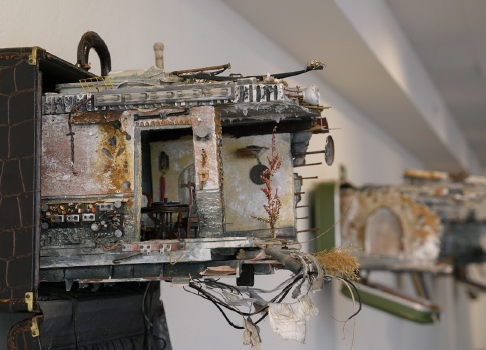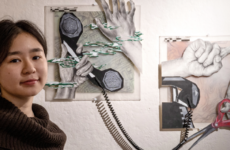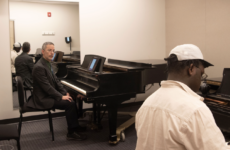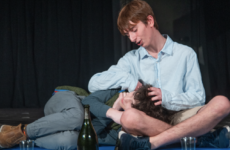
Mr. Mohamad Hafez’s “UNPACKED: Refugee Baggage” collection showcases surreal Middle Eastern landscapes. His work is displayed in the Paul Mellon Arts Center until November 3.
By Leilani Gao ’26
Featured on the National Public Radio, The New York Times, The Guardian, and The New Yorker, internationally acclaimed artist and architect Mr. Mohamad Hafez’s art is on display in Choate’s Paul Mellon Arts Center (PMAC), where it will remain until its closing reception on November 3.
The exhibited artwork is from the “UNPACKED: Refugee Baggage” collection. Through a blend of found objects, paint, and scrap metal, Mr. Hafez crafted visual landscapes that tell the stories of refugees who escaped war-torn regions of the Middle East.
Mr. Hafez described his art as a “self-taught artistic expression regarding the tools and methodology.” The years he spent as an architecture student now play an important role in his modeling work.
Coming to the U.S. as an international student from Syria and Saudi Arabia, Mr. Hafez’s cultural identity has influenced his artwork. “My background as an Arab-Muslim artist shows up in my art through calligraphy and use of Islamic design, motifs, and patterns,” Mr. Hafez said. “[It’s] just brainstorming for a long time and looking at a lot of photos of old Damascus, where I come from. And then I start modeling.”
Art teacher Mr. Aaron Sober led the process of putting together the installation and contacting Mr. Hafez. He appreciated Mr. Hafez’s ability to communicate personal, political, and economic narratives through an artistic medium. “I have been an artist for all my life now, and I believe in the power of creativity. It’s a great tool for understanding the world,” he said.
Visual artist Dana Chung ’26 was inspired after seeing Mr. Hafez’s work on display. “You see the cross-cultural dimensions of street art intertwined with sculptural work through his cultural background,” she said.
Mr. Sober, on the other hand, admired the juxtaposing nature of Mr. Hafez’s collection. “His work fuses domestic scenes and situations, like a breakfast table set in the morning, with a huge amount of disruption and violence,” he said. “I think that the dissonance between the very domestic, comforting, family situations and a total upheaval is really interesting.”
One of Mr. Hafez’s more abstract pieces caught the eye of Arts Concentration student Katherine Chong ’25. “Compared to the other hyperrealistic dioramas of war-torn regions, it was a dystopian city built of little wires, bricks, and blocks,” she said. “It was touching more on the idea of home and belonging, and I was really drawn to it.”
In November, Chong and her fellow Arts Concentration classmates will visit Mr. Hafez’s studio in New Haven. There, they will create their own projects using found objects, which will be featured in the PMAC Gallery alongside Mr. Hafez’s work. They will also stop for a bite at Mr. Hafez’s Pistachio Cafe, which features Middle Eastern and Mediterranean drinks and desserts.
By reflecting on and exploring his past experiences, Mr. Hafez has found a unique way to tell his story through art. Through Mr. Hafez’s display, Mr. Sober hopes students can learn “how art can communicate the complex reality of the human condition in a way that no other subject can.”




